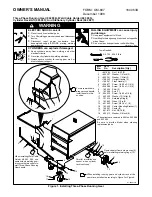
20
–
The panel beeps;
–
The indicators COM FAULT, POWER, LP1 - LP4
1.
Illuminate with amber, then
2.
Illuminate with green, then
3.
Illuminate with red, then
4.
One-by-one turns on with green, and finally
5.
One-by-one turns on with red.
After the test has been completed the panel automatically exits the self-diagnostic mode and
returns to quiescent mode.
TRANSMITTING NOTIFICATIONS
Notification Formats
The UO-4S can transmit notifications to five phone numbers and for each number a notification
format can be programmed individually:
•
Contact ID (ADEMCO) – Appendix A;
•
User SMS – Appendix B;
•
Egida-2 SMS – Appendix C;
•
Egida-3 SMS – Appendix D;
•
Voice Message – Appendix E;
•
Phone Call;
•
CSD;
•
CSD (DC-09).
Contact ID (ADEMCO)
This notification type is used to transmit events via voice channels to central monitoring stations.
The list and format of notifications is shown in Appendix A. An UOP-3 GSM can be used as a receiving
device.
User SMS
The panel supports transmitting user messages both in Cyrillic and Latin characters and provides
editing them by means of UProg (using Latin character provides more cost-effective way to send SMS).
Depending on the mode the device operates in the data transmitted in user SMS vary in follow
aspects:
Standalone Mode: messages are sent with specifying alarm loop numbers:
Object Name, DD-MM (optionally) HH:MM, Event, LP, Zone Description (optionally)
Object Name, DD-MM (optionally) HH:MM, Event, User Number, User Description (optionally)
Slave 1, Slave 2, Master Mode: messages are sent with specifying numbers of partitions and
zones:
Object Name, DD-MM (optionally) HH:MM, Event, Partition Number, Zone Number, Zone Description (optional)
Object Name, DD-MM (optionally) HH:MM, Event, Partition Number, User Number, User Description (optional)
The list of messages is shown in Appendix B.
















































